Curriculum By Grade
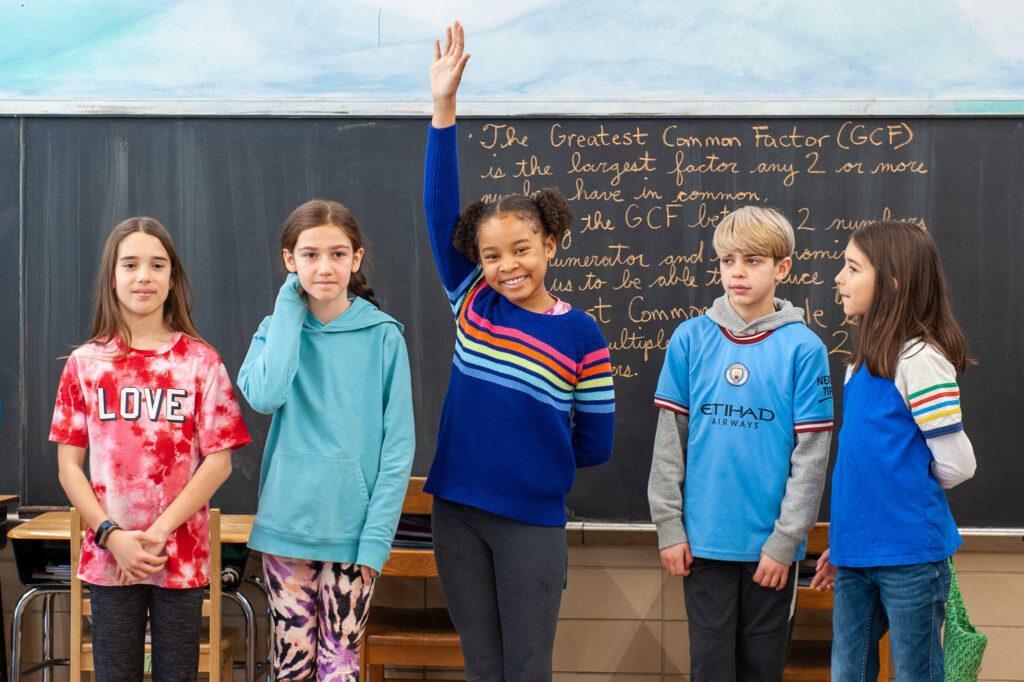
Learning is the primary goal, not testing or external rewards. Special subject integration into main lesson material is key to the holistic academic experience. Waldorf education curriculum incorporates art, music, and craftsmanship alongside reading, writing, math, and science. Academic concepts are taught by the block method of studying a particular theme for a number of weeks. See curriculum details by grade below or click here for our curriculum one sheet.
Mathematics: Whole numbers and the four processes of arithmetic are taught using multidisciplinary methods like movement, recitation, manipulatives, music and cooking. Science: Nature focused study of seasons & life cycles are taught w/ nature hikes & observation. Spanish: New language familiarity starts w/ songs, verse, counting & colors using multidisciplinary methods like movement, music & art. History & Geography: The stories of Saints, fairy tales and folklore introduce history & mythology concepts through imaginative and exciting narratives. Music: Pentatonic flute, choral melody, rhythm & meter is taught through multidisciplinary methods including games & movement Art & Handwork: Student learn simple pattern form drawing, watercolor painting, hand sewing, knitting & beeswax modeling. Movement: Outdoor recess 3x a day. Non-competitive games & activities in PE class. Extra Lesson builds spatial awareness, sensory integration and other motor skills.
Mathematics: Multiplication tables are introduced. Process relations, carrying & borrowing are taught using multidisciplinary methods. Science: Expanded nature studies are taught using gardening, nature hikes & cooking. Spanish: Vocabulary and common language basics begin (counting, animals, seasons & months) taught through story & imitation using multidisciplinary teaching methods. History & Geography: Native American story myth & legend teaches children in local history & geography through compelling story. Music: Pentatonic flute continues. Choral music songs that reflect language arts & history curriculum using multidisciplinary methods. Art & Handwork: More complex form drawing is added, watercolor continues, crocheting introduced & beeswax modeling continues. Movement: Outdoor recess 3x a day. Non-competitive games & activities in PE class. Extra Lesson builds spatial awareness, sensory integration and other motor skills.
Mathematics: Multiplication tables, measurement, time, patterns, carrying & borrowing are taught using multidisciplinary methods. The class building project reinforces this work. Science: The third grade garden teaches botany via farming, soil study, seed life. Spanish: Nouns & verbs added to vocabulary & language knowledge through story & imitation while using multidisciplinary teaching methods. History & Geography: Ancient history & Middle Eastern geography are taught through Old Testament stories. A small scale house building project introduces early culture housing by geographic region. Music: Students learn recorder, are introduced to violin & begin music notation. Choral music reflects language arts & history curriculum Art & Handwork: Form drawing continues along with watercolor painting, crocheting & beeswax modeling. Embroidery is introduced. Movement: Outdoor recess 3x a day. Non-competitive games & activities in PE class. The beginnings of more complex games & sports are introduced. Extra Lesson builds spatial awareness, sensory integration and other motor skills.
Mathematics: Word problems, fractions, long division, averages & factoring are taught through multidisciplinary methods. Science: Gardening continues. Zoology is studied with reading, researching, writing, nature hikes, art & field trips. Spanish: Grammar, writing, reading, dictation added to earlier studies. Taught through story & imitation while leveraging multidisciplinary methods. History & Geography: Ohio history is taught along with indigenous people settlement & geography.Norse mythology & Scandinavian history is also taught. Music: Violin study begins in earnest. Students continue recorder. Choral music reflects language arts & history curriculum. Art & Handwork: Form drawing moves into geometric drawing, watercolor painting continues. Cross stitch & clay modeling is introduced. Earlier handwork continues. Movement: Outdoor recess 3x a day. Extra lesson may continue. More complex games are explored in PE class such as kickball, basketball, gymnastics. Competition via teamwork is introduced.
Mathematics: Teaching focused on decimals, fractions, mixed numbers and the metric system. Lessons are taught through multidisciplinary methods (such as movement, recitation, manipulatives, music, cooking, etc.) Science: A great expansion of botany is studied including seed, tree and other plant life in all stages and great detail. Animal environmental adaptation is discussed. Spanish: Grammar, simple text, syntax and short descriptions are taught while leveraging multidisciplinary methods (such as movement, music and art, etc.). History & Geography: The cultures of ancient India, Persia, Mesopotamia, Egypt and Greece are studied through writing, note copying, reading, project work, theater, music and art. Music: Students continue recorder, violin and layer multi-part vocals into choir. Students also learn the major and minor scale and Greek music as related to the Literature and History block. Art & Handwork: The class studies complex form drawing, geometric drawing, watercolor painting, chain stitch, clay and students begin woodworking Movement: The focus is on preparing for the Greek Pentathlon, which introduces competitive sporting through traditional, ancient track & field events. Eurythmy work expands and continues.
Mathematics: Practical application, geometry & beginning algebra are the focus. Lessons are taught through multidisciplinary methods (such as movement, recitation, manipulatives, music, cooking, etc.) Science: Continued botany, physics and geology are learned via reading, researching, writing, experimentation, Socratic inquiry, art and field trips. Spanish: Students begin to read texts, stories and write language via translations. History & Geography: Founding of Rome, Life of Christ, Crusades, Life of Mohammed, Islam and Medieval society are studied through writing, note taking, reading, project work, theater, music and art. Students also have an additional geography study of Canada, Central and South America. Music: Students learn both alto and tenor recorders, orchestra, choir, minstrel songs and Roman music as related to the Literature and History block. Art & Handwork: A continuation of lessons in form drawing, geometric drawing, watercolor painting, four needle knitting, clay and woodworking. Movement: Softball, basketball, gymnastics, kickball, volleyball and other complex and competitive team and individualized sport are the focus. Team sports are not offered. Eurythmy work expands and continues. The students attend the Medieval Games to further challenge their spirits and physical beings.
Mathematics: Algebra, practical applications, area powers and roots and learned via manipulatives, real world applications and note taking. Science: Chemistry, Physiology, Physics and Astronomy as learned via reading, researching, writing, experimentation, Socratic inquiry, art and field trips. Spanish: Reading, conversation, poetry and advanced grammar are taught along with continuing study of writing and translation History & Geography: Students study 1400-1700 Age of Exploration, Age of Discovery, Reformation and Renaissance through writing, note taking, reading, project work, theater, music and art. Students also have an additional geography study of Africa and Europe. Students attend the Renaissance Faire, which allows students reflect upon curriculum and strengthen their cognitive, creative, and social skills. Music: Students learn both alto and tenor recorders, orchestra, choir, and Renaissance music as related to the Literature and History block. Art & Handwork: Watercolor, geometric drawing, felting, perspective drawing, and woodworking Movement: Softball, basketball, gymnastics, kickball, volleyball and other complex and competitive team and individualized sport are the focus. Team sports are not offered. Eurythmy work expands and continues.
Mathematics: A continuation of more complex forms of Algebra, practical math applications, area powers and roots learned via manipulatives, real world applications and note taking. Science: Chemistry, Anatomy, Physiology and Physics as learned via reading, researching, writing, experimentation, Socratic inquiry, art and field trips. Spanish: Review and constitution of all skills — vocabulary building, dialogue, grammar and syntax. History & Geography: Students study 1700 – Present. U.S. History, the industrial revolution and comparative biographies through reading, research, writing, reports, note taking, project work, theater, music and art. Students also have an additional geography study of Asia, Antarctica, and the larger world. Music: Students learn both alto and tenor recorders, orchestra, choir, symphonic form, and American music as related to the Literature and History block. Art & Handwork: Art History, watercolor, solid geometric drawing, charcoal drawing and woodworking. Student hand make a chair. Movement: Softball, basketball, gymnastics, kickball, volleyball and other complex and competitive team and individualized sport are the focus. Team sports are not offered. Eurythmy work expands and continues. Grade 1
 Language Arts: Movement, recitation, storytelling, art and music teach reading and writing basics (introduction to letters and writing) through folktales, fairy tales and Saint stories.
Language Arts: Movement, recitation, storytelling, art and music teach reading and writing basics (introduction to letters and writing) through folktales, fairy tales and Saint stories.Grade 2
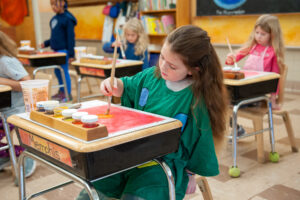 Language Arts: Multidisciplinary teaching methods continue. Reading and writing sentences, rhyming words, and speech work taught through stories of indigenous people.
Language Arts: Multidisciplinary teaching methods continue. Reading and writing sentences, rhyming words, and speech work taught through stories of indigenous people.Grade 3
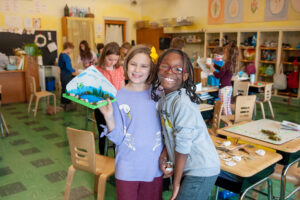 Language Arts: Sentence structure, word types, punctuation & spelling are taught through multidisciplinary methods. Hebrew Stories and Ancient History tie into multiple subjects.
Language Arts: Sentence structure, word types, punctuation & spelling are taught through multidisciplinary methods. Hebrew Stories and Ancient History tie into multiple subjects.Grade 4
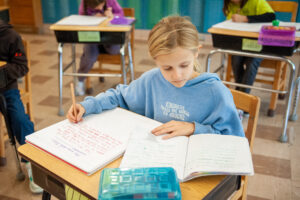 Language Arts: Expanded word types, writing composition, grammar, vocabulary & spelling are taught through Norse mythology using multidisciplinary methods.
Language Arts: Expanded word types, writing composition, grammar, vocabulary & spelling are taught through Norse mythology using multidisciplinary methods. Grade 5
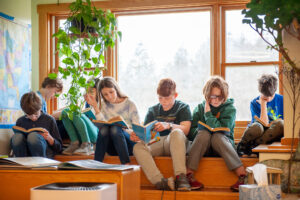 Language Arts: Students focus on parts of speech syntax, research papers, vocabulary & spelling. Multidisciplinary teaching methods are used (such as movement, recitation, theater, art, music, etc.). Lessons relate to the History, Science and Math block.
Language Arts: Students focus on parts of speech syntax, research papers, vocabulary & spelling. Multidisciplinary teaching methods are used (such as movement, recitation, theater, art, music, etc.). Lessons relate to the History, Science and Math block.Grade 6
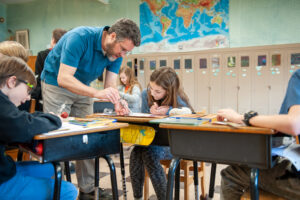 Language Arts: Advanced grammar, composition, exposition, narration, description, outlining & vocabulary. Multidisciplinary teaching methods are used (such as movement, recitation, theater, art, music, etc.). Lessons relate to the History, Science and Math block.
Language Arts: Advanced grammar, composition, exposition, narration, description, outlining & vocabulary. Multidisciplinary teaching methods are used (such as movement, recitation, theater, art, music, etc.). Lessons relate to the History, Science and Math block.Grade 7
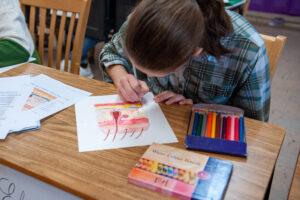 Language Arts: Expansion and review of all grammar, essays reading & writing, complex compositions, poetic forms, vocabulary and spelling are studied. Multidisciplinary teaching methods are used (such as movement, recitation, theater, art, music, etc.) Lessons relate to the History, Science and Math block.
Language Arts: Expansion and review of all grammar, essays reading & writing, complex compositions, poetic forms, vocabulary and spelling are studied. Multidisciplinary teaching methods are used (such as movement, recitation, theater, art, music, etc.) Lessons relate to the History, Science and Math block.Grade 8
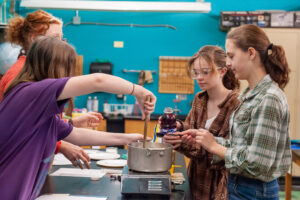 Language Arts: Review all grammar, newspaper reporting, business and practical writing. Multidisciplinary teaching methods are used (such as movement, recitation, theater, art, music, etc.). Lessons relate to the History, Science and Math block.
Language Arts: Review all grammar, newspaper reporting, business and practical writing. Multidisciplinary teaching methods are used (such as movement, recitation, theater, art, music, etc.). Lessons relate to the History, Science and Math block.
